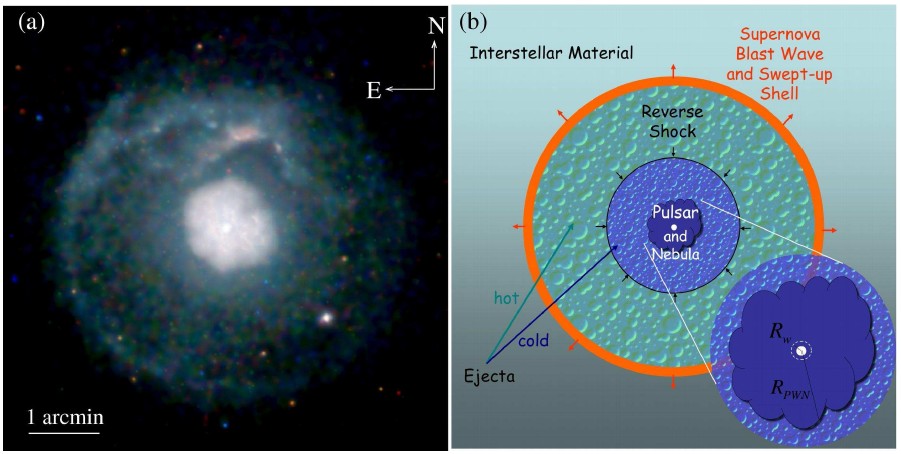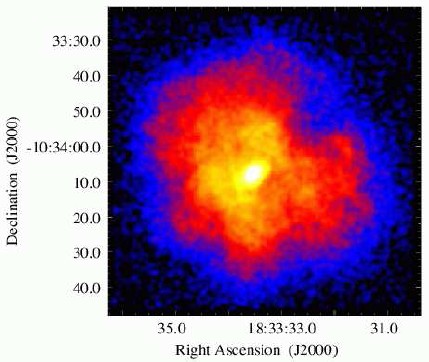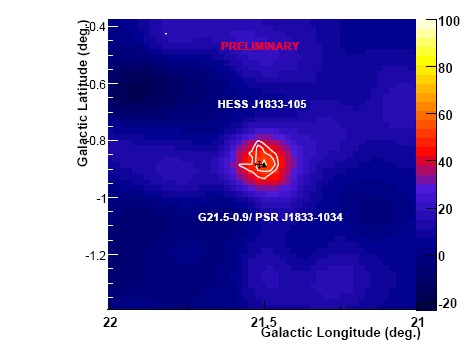A New Companion for the Lonely Crab? Gamma Rays from G21.5-0.9
February 2008

The standard candle of VHE astronomy, the Crab Nebula, has served for decades as a yardstick in almost all wavelengths, and yet it is a very peculiar object, harboring the most energetic and one of the youngest pulsars of our Galaxy. In the VHE domain, H.E.S.S. has revealed more than a dozen pulsar wind nebulae (PWN), either firmly established as such or compelling candidates (e.g. SOM 9/05, SOM 4/06, SOM 5/06, SOM 6/07), almost all of which are middle-aged (at least few kyrs up to 100 kyrs, except MSH 15-52) and which exhibit an extended VHE nebula with an offset between the pulsar position and the nebula center, quite different from the (for gamma-ray instruments) point-like Crab Nebula. The remnant G21.5-0.9 (Wilson and Weiler 1976) was previously classified as one of the about ten Crab-like SNR, and was already in 1995 predicted as a gamma-ray source with a flux of a few % of the Crab flux and hard spectrum (de Jager et al.). Chandra images (Safi-Harb et al, 2001; Bocchino et al., 2005) beautifully reveal the composite nature of the remnant, consisting of a spherical shell of 4' diameter, tracing the supernova blast wave, and a pulsar wind nebula of about 1' size, of high-energy electrons accelerated in a pulsar created in the explosion (Top figure and Fig. 1). Finally, in 2005, the 61.8 ms pulsar PSR J1833-1034, with a spin-down power of ˙E = 3.3 × 10^37erg/s and a characteristic age of 4.9 kyr was discovered through its faint radio pulsed emission (Gupta et al., 2005, Camilo et al., 2006). PSR J1833-1034 in G 21.5-0.9 is the second most energetic pulsar known in the Galaxy.
Data obtained in the H.E.S.S. Galactic Plane Survey (SOM 12/07) finally seem to confirm the predictions of G21.5-0.9 as a VHE gamma-ray source and as a companion of the Crab Nebula. At the 2007 ICRC in Merida, evidence for the source HESS J1833-105 was presented (Djannati-Atai et al. , 2007), detected at a level of more than 6 standard deviations in about 20 h of observations (Fig. 2). The location of the source is determined with a precision of better than 1' and coincides with the location of PSR J1833-1034 in G 21.5-0.9. On the scale of the H.E.S.S. angular resolution of 4', the source appears point-like. The gamma ray flux, measured between 200 GeV and 5 TeV, corresponds to about 2% of that of the Crab Nebula, close to the predicted value. Why is G21.5-0.9, like the Crab Nebula, much more compact than most other PWN seen by HESS? One reason is obviously their relatively young age, giving the nebulae less time to expand. Most likely more important is the high luminosity of the pulsar, which generates relatively high magnetic fields in the nebula, resulting in strong synchrotron radiation losses and short lifetimes - and hence short range - of the accelerated electrons. G21.5-0.9 and the Crab Nebula are therefore rather inefficient gamma-ray sources, in the sense that synchrotron radiation losses dominate over Inverse-Compton production of high energy gamma rays: in the Crab nebula, the synchrotron luminosity is about 100 times higher than the gamma ray luminosity, in G21.5 it is by a factor of 30 higher.
References:
"New Companions for the lonely Crab? VHE emission
from young pulsar wind nebulae revealed by H.E.S.S."
H.E.S.S. collaboration, A. Djannati-Atai et al. , Proc. 30th International
Cosmic Ray Conference, Merida, 2007,
arXiv:0710.2247

